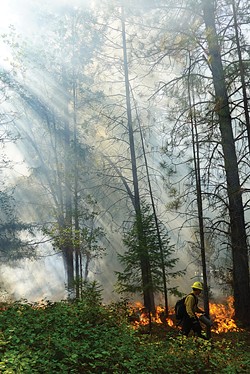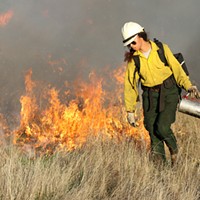[
{
"name": "Top Stories Video Pair",
"insertPoint": "7",
"component": "17087298",
"parentWrapperClass": "fdn-ads-inline-content-block",
"requiredCountToDisplay": "1"
}
]
I never forget watching a crew starting a prescribed burn in the woods near my neighbor's home back in late spring 2008, in an era when wildfires were just starting to get crazy and often unstoppable.
I remember Will Harling handed me a drip torch and told me where to safely light the undergrowth, so when wildfire came, and it surely would, this intentional burn scar might protect the neighborhood.
Harling is now a director of the Mid Klamath Watershed Council, a fast-growing nonprofit based in Orleans. Upriver, locals call the group "Mick-Wick" for its less pronounceable acronym, MKWC.
They started the fires with drip torches that looked like tall aluminum tea pots with curls in their spouts. But instead of mint tea, they squirted out dribbles of flame on the ground. These "tea pots" were full of a mix of diesel fuel and gasoline and the flames started to spread quickly in the forest undergrowth, but not too quickly, and that's the idea.
Here and there, the flames would race up the moss on a tanoak tree, but they were overall well behaved.
There were veteran burners on the crew, including John Gibbons, a long time fireman with the U.S. Forest Service, and Bill Tripp, now director of natural resources for the Karuk Tribe. I'd worked wildfires with Gibbons years before when I was on USFS fire suppression crews, and Tripp had been part of tribal crews burning off small areas on Offield Mountain back in the early 2000s until high placed Forest Service management shut the tribal burns down.
Nearby, Luna Latimer, the other MKWC director, frequently twirled a humidity measuring tool called a sling psychrometer. It has two thermometers, one wrapped in a wet wick of cotton, the other bare. The evaporation of the cotton wrapping cools that thermometer and the difference between the two reveals the relative humidity, or RH, as it's known in fire circles.
Latimer explained that the lighting would have to stop if the RH fell below 18 percent. According to the burn permit, that would be too dry for safe ignition and it had been falling in that direction for the last few readings. She finished the measurement and announced loudly that the new reading was 17 percent. The lighters blew out their drip torches and switched to look-out mode.
I privately wondered if someone far away had pulled the number "18" out of their hat to create an illusion of caution but, just then, someone down the line yelled, "It just spotted across the road!"
Harling crossed the dirt road in a flash and quickly crushed a smoldering pile of forest detritus with his boots and a hand fire tool called a McCloud. That was the only spot fire that afternoon, but it was enough to evaporate my skepticism.
Fast forward several years to the present and wildfire has become the grim seasonal reality in California and the West, seemingly bigger and more unstoppable every year. Urban communities are getting scorched almost as much as rural ones, and the fire season seems to expand on the calendar year by year. Not coincidentally, the support and demand for prescribed burning continues to grow.
One of the areas where it's grown in popularity has been in the California Legislature, which has passed new laws, and the halls of Congress, where companion bills have been introduced in the House and the Senate.
A key champion and intellectual well-spring for some of the state legislation has been Lenya Quinn-Davidson, fire advisor for the University of California Cooperative Extension and director of the Northern California Prescribed Fire Council. Legislative aides who worked on Assembly Bill 642 and others who developed Senate Bill 332 give Quinn-Davidson credit as a key lobbyist in helping to develop the new laws, both of which were signed by the governor.
A.B. 642, Quinn-Davidson explained, creates major training programs and mandates that the state develop a prescribed burning training center to build the workforce of qualified practitioners. After its passage, she said the state needn't require people to go to an urban area and sit in a classroom, a reference to suggestions of CalFire locating a training center at a U.S. Air Force base in the Sacramento area.
"We are arguing for more dispersed training centers," she said. "People need to put pressure on the agencies. The language of the new law requires collaboration."
Quinn-Davidson called these dispersed centers "satellite burning operations" and they coincide with an ongoing campaign of Tripp's to build one in the mid-Klamath area.
The bill was authored by Assemblymember Laura Friedman, whose southern California district stretches from the urban areas of Burbank and Glendale into the mountains to the north. Friedman has identified wildfire as the most pressing issue facing the state.
The formal discussion of the bill observes that recent wildfires, even the largest of them, have been buffered when their intensity and spread is halted in areas that have been treated with prescribed burns. The bill's analysis predicts it "would result in potentially significant savings due to avoided fire suppression costs."
The most significant aspect of Senate Bill 332 is that it insulates prescribed fire burn bosses and private property owners from liability in the case of an escaped burn, unless it was conducted "in a grossly negligent manner."
The permitting process, with its attention to appropriate weather, fuel conditions, air quality and staffing, already makes escaped burns very rare. A 2005 study by the U.S. Forest Service noted that 99 percent of prescribed burns have no reported escapes. In wildfire suppression, fire lines fail far more frequently.
Senator Bill Dodd, who authored of S.B. 332, saw large wildfires char chunks of his district, which spans all or portions of Contra Costa, Napa, Sacramento, Solano, Sonoma and Yolo counties, in 2017 and 2020.
His staff explained, "The intent was to encourage more prescribed burning. Burn bosses and property owners are hesitant because of all the liability if a burn should escape," noting that CalFire could charge them with the costs of suppressing an escape burn.
The difference between "simple negligence," the previous state standard, and "gross negligence," the replacement standard, lies "in the severity of carelessness" requiring that a person fall so far behind the "reasonable standard of care" their conduct can be considered "extreme."
The state included a $20 million prescribed fire claim fund as a complement of the bill.
On the federal level, companion bills have been introduced to radically increase the use of prescribed burning. They are House Resolution 3442 in the House of Representatives and Senate Bill 1734 in the Senate.
North Coast Rep. Jared Huffman, whose district stretches from Marin County north to the Oregon/California state line, has signed on as a co-sponsor and says the bill has a good chance of passage, although it may be re-packaged into one or more larger bills.
"I'm passionate about expanding prescribed burns as our best tool to promote forest health and resilience," Huffman said, explaining that "five consecutive fire seasons in a row set the stage" for the bill. He noted that Mike Simpson, a Republican representative from Idaho, has also sponsored the bill, suggesting it may get more bipartisan support than some other proposals have in a divided and partisan congress.
Huffman also said the bill has gotten support from timber interest groups that have typically lobbied for logging as the solution to reduce wildfires.
"A lot of timber landowners want to do some of this kind of burning," he said. "Fires don't stop at the property lines. It requires collaboration."
Huffman said another part of the bill was "the tribal piece. Tribes like the Karuk Tribe are perfect partners in this effort and it's a beautiful thing to come back to this kind of traditional knowledge and practice as an answer to our modern day problem."
On the Senate side, the companion bill was introduced by Sen. Ron Wyden (D-Oregon) and its co-sponsors include Senators Dianne Feinstein (D-California), Maria Cantwell (D-Washington) Joe Manchin, III (D-West Virginia).
"When these forestry and public lands bills are introduced, they may move as part of a package of bills," said a spokesperson for Wyden's office. "They may get folded into a larger package. The bill has gotten a lot of support from all sides. We have a cross section of supporters, including timber groups, environmental groups, small saw mills, tribal groups. It's broad and comprehensive."
Manchin chairs the Senate's Committee on Energy and Natural Resources, which conducted initial hearings in mid-October.
"These are not your grandfather's fires. They are bigger, they are hotter, they are more powerful," Wyden said during the bill's hearing. "My bill gives us a chance to go in and do some of the heavy lifting in the cooler weather when you can carefully control fire and, in the process, avoid infernos that we would otherwise have when it's hot and dry in the summer."
Wyden pointed out the success of prescribed burns in protecting central Oregon.
"The reason I feel so strongly about the prescribed fire legislation is I've seen the results on the ground," he said. "Folks in Central Oregon, Sisters specifically, feel that prescribed fire saved the town of Sisters. Period. Full stop."
Malcolm Terence is a freelance journalist whose work can also be found in the Two Rivers Tribune, Siskiyou Daily News and the Los Angeles Times. He is the author of a book about up-river life starting with the Black Bear commune in the late 1960s titled Beginner's Luck, which is published by Oregon State University Press.
more from the author
-
'Given These Songs'
Native singers gather to thank Brian Tripp; he thanks them back
- Jun 17, 2021
-
Fighting Fire with Fire
A devastating wildfire season highlights the need for prescribed burns
- Nov 5, 2020
- More »
Latest in News
Readers also liked…
-
Through Mark Larson's Lens
A local photographer's favorite images of 2022 in Humboldt
- Jan 5, 2023
-
'To Celebrate Our Sovereignty'
Yurok Tribe to host gathering honoring 'ultimate river warrior' on the anniversary of the U.S. Supreme Court ruling that changed everything
- Jun 8, 2023

































